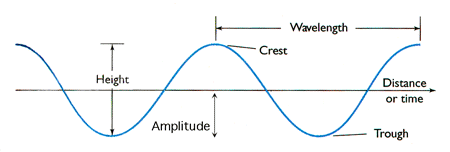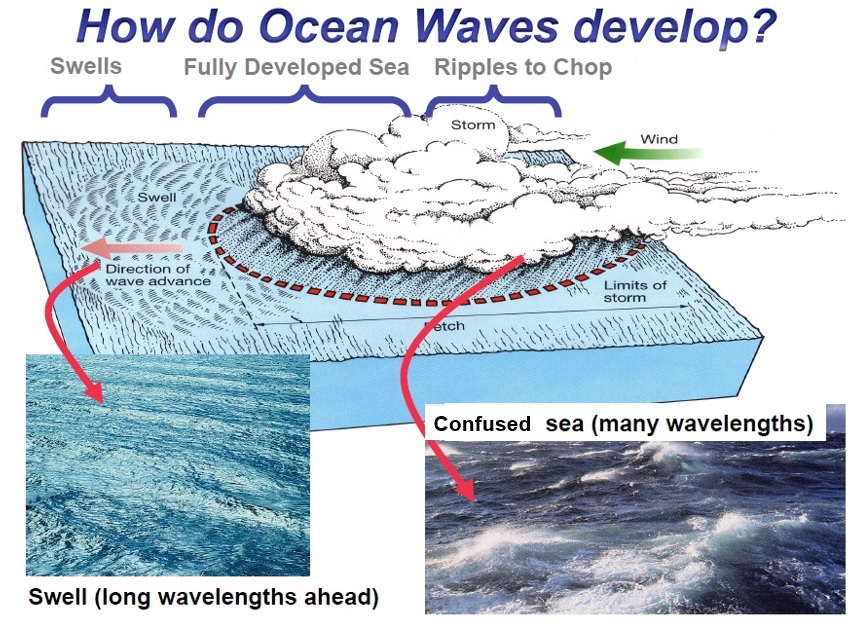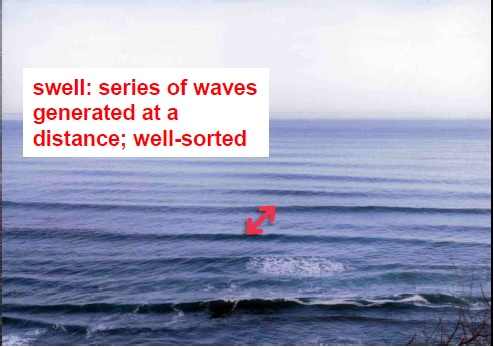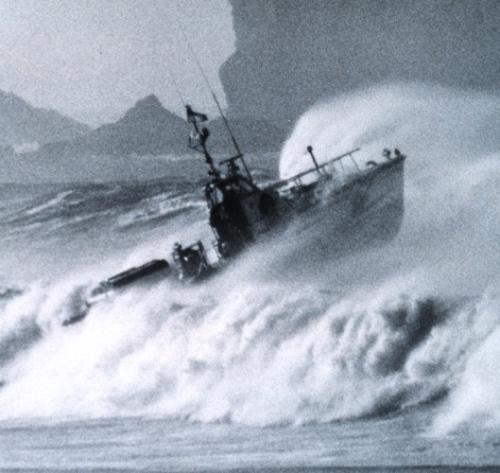ATSC 113 Weather for Sailing, Flying & Snow Sports
Wave Characteristics
Learning Goals 8b:
1) Describe the relationships between wave characteristics including shape, wavelength, period, amplitude, steepness, phase and group velocities, and wave trains.
2) Explain how wind-generated waves, swell, rogue waves, and tsunamis are formed.

Crest = Highest point of the wave
Trough = Lowest point of the wave
Wavelength = Distance from one crest/trough to the next (m)
Wave Height = Height from trough to crest (m)
Wave steepness = ratio of wave height to wavelength
Amplitude = distance from the centre of wave to the bottom of the trough (m)
Wave Period = time for one full wavelength to pass a given point (s)
These characteristics are important in determining the size of waves, the speed at which they travel, how they break on shore, and much more. We will refer back to them throughout the following unit.
Wave Development and Movement
Waves typically propagate from the centre of a storm. These waves combine with pre-existing waves, creating a confused sea with large and small waves of varying wavelengths moving in all directions. Some waves will move in the same direction as the storm, and these will likely grow bigger. Others will head off in the opposite direction, and these will likely lose energy over time and fade away. The faster waves (i.e. longer wavelength and shorter wave period) will overtake any smaller waves, and these will be the first waves to break on distant shores. As the waves continue to disperse from the storm, they settle into groups of different wave sizes and velocities continuously moving away from the source. This is known as a wave train.

Source: UBC EOSC 114
Wave energy is associated with a group of waves. Waves in a group are dynamic as they travel with smaller waves at the leading (front) and trailing (rear) sides of the group, and larger waves in the middle. Waves move through the group from the rear to the front, first gaining in size, then shrinking as they approach the front of the group, then disappearing. Meanwhile, new waves are forming at the rear of the group and moving through the group. This pattern is due to deep water wave dynamics, which we will not get into here.
- https://www.youtube.com/watch?v=lWi_KpBy8kU compare the waves behind this boat with the animated diagram below.
The speed at which this one group of waves travels across the water is known as the group velocity. The apparent speed of each individual wave in the group is known as the phase velocity. This phase velocity is the speed at which a single phase of a wave (e.g. a crest) moves across the water and it is typically double the group velocity.
In the simulation below, four groups of waves are shown with the red dot representing the phase velocity and the green dot representing the group velocity.
![]()
Source: Kraaiennest - Own work, GFDL, https://commons.wikimedia.org/w/index.php?curid=3651297
Why do we care about group velocity? Because the destructiveness of waves comes from its energy, and the energy moves with the wave groups, not with the wave crests.Types of Waves
Wind-generated waves
Wind-waves are a result of wind disturbing the ocean surface and displacing water. Natural forces, such as the water’s surface tension (capillarity), or gravity, work to restore the disturbed water to its calm state, flattening the water’s surface. Different types of waves are named for their restoring force. Small winds displace small amounts of water on the surface, creating very short-wavelength capillary waves. Here, capillarity acts as the restoring force. Capillary waves are typically only a few cm in length. Larger winds create gravity waves, for which gravity acts as the restoring force. These waves can be metres to kilometers long.

Swell
Waves that you see on the ocean surface on a non-stormy day are not actually formed by local winds, but instead are formed by winds from distant storms. These waves that arive from distant sources are known as swell. Swell are gravity waves originating from heavy winds and are capable of travelling long distances across the ocean with little loss of energy. Ocean swell is typically generated by storms out at sea (far from shore) and can carry energy to distant shores where it crashes as breaking waves. Swell with longer wavelengths tend to have lower wave heights and are less susceptible to decay from surface winds. They also carry more energy, and are more likely to form large breakers once they reach the shore.
Swell, like an airplane, takes the shortest distance across the
Earth’s surface as it travels. These routes are known as Great Circle
routes or paths. The shortest distance between two points on a sphere,
like the Earth, is not a straight line but rather a curve. To picture a
great-circle path between two points, it would be the path over a small
globe along which an elastic band would lie if stretched between those
two end points.
When out on the water, you may notice different swell coming from different directions. Depending on the size of the swell and the direction that it’s travelling in, when it meets other swell, it can produce diamond-shaped or hatched wave patterns. Add wind waves on top of the swell and you might be in a confused sea.
If you leave Vancouver in your sailboat and head out into the Strait of Georgia, you will likely only experience small waves and chop created by local winds and tides. This is because Vancouver Island lies between the Strait and the open ocean, and protects you from ocean swell. Incoming swell from distant storms breaks upon the shores of Vancouver Island and is dispersed as it wraps around the south end of the Island into the Strait. If you were to take your sailboat around the south end of Vancouver Island and out into the Pacific, you would immediately notice a difference. Your boat would start to rise and fall with the incoming ocean swell, which can be quite large at times.

Source: UBC EOSC 114
Rogue Waves (and Interference)
These are very large waves that form due to wave interference. What
is interference? When two waves run through each other, they can add up
or cancel out. This property of waves is known as interference. If the
crest of one wave passes through the trough of another, they cancel out,
which is called destructive interference.
The resulting wave is smaller and carries less energy. Whereas if the
crest of one wave passes through with the crest of another wave, they add up,
which is called constructive interference.
The resulting wave is bigger, carries higher energy, but are temporary (short lived). Rogue waves are the result of constructive
interference that causes the wave height to be unusually higher than
the other waves around it, and can catch boaters (and people on the shore) by surprise.
- https://www.youtube.com/watch?v=SiHHz1yUaAU rogue wave on shore
- https://www.youtube.com/watch?v=eMBU1eXDYDc simulated rogue wave in wave tank
- https://www.youtube.com/watch?v=szk83cONAqM rogue wave hits yacht (view last 30 seconds)
As viewed from the cockpit of your sailboat, a rogue wave would appear to rise out of nowhere and disappear quickly. You may not see them coming, and often have little or no time to take action. Large rogue waves can be very dangerous.

Tsunamis
Tsunamis are very long wavelength waves resulting from seismic events, such as earthquakes, under-water landslides, or volcanic eruptions. Wavelengths can be >200km with long wave periods. In the open ocean (away from shore) they travel very fast (the same speed as a jet airliner), but have very small amplitude (cm to a meter or so). Thus, they have very small wave slopes, and you might not even notice it in the deep ocean, because the normal wind-waves would catch your attention instead. They may start small-amplitude out at sea, but when they meet a continental shelf, their wave height increases dramatically, creating a wall of water approaching the shore.
Videos: (non-required material)
Ocean Waves (Part 1): Wave Structure & Formation: https://www.youtube.com/watch?v=KtHZWO3k7QU
Keywords: crest, trough, wavelength, wave height, wave steepness, amplitude, wave period, confused sea, wave train, swell, group velocity, phase velocity, capillary waves, gravity waves, rogue wave, constructive and destructive interference
Image credits: Government sources for the tables above are indicated in or near the table captions, and in the Extra Info box.